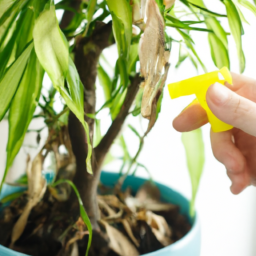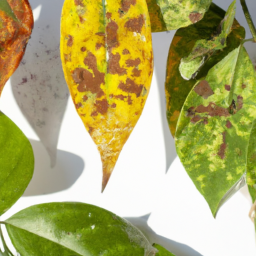
Hey there, fellow plant enthusiasts! Today, we’re diving into the fascinating world of diagnosing plant diseases. If you’ve ever noticed yellow leaves, mysterious mold, or any other peculiarities in your beloved greenery, you’re in the right place. In this blog post, we’ll explore the common signs and symptoms of plant diseases, and equip you with the knowledge to identify and address these issues head-on. So, grab your gardening gloves and let’s get started on our journey of diagnosing plant diseases: yellow leaves, mold, and more!
Common Causes of Yellow Leaves in Plants
Yellow leaves on plants can be a cause for concern, as they often indicate an underlying issue with the health of the plant. By understanding the common causes of yellow leaves, you can take appropriate steps to diagnose and treat the problem. In this guide, we will explore some of the most common reasons why plant leaves turn yellow.
Nutrient Deficiencies
One of the primary causes of yellow leaves in plants is nutrient deficiencies. When plants lack essential nutrients, such as nitrogen, iron, or magnesium, their leaves may start to turn yellow. Nitrogen deficiency, for example, often leads to uniform yellowing of older leaves while the veins remain green. Iron deficiency, on the other hand, may cause interveinal chlorosis, where the tissue between the veins turns yellow.
To address nutrient deficiencies, it is crucial to identify the specific nutrient lacking in your plants. Conduct a soil test to determine the nutrient levels and adjust your fertilization practices accordingly. In some cases, foliar sprays containing the deficient nutrient can be applied directly to the leaves to provide a quick boost.
Additionally, consider the pH of your soil, as it can impact nutrient availability. Adjusting the pH to the appropriate range for your plants can help ensure they can absorb the necessary nutrients from the soil.
Overwatering and Poor Drainage
Overwatering is another common cause of yellow leaves in plants. When the roots of a plant are constantly saturated with water, they can become deprived of oxygen, leading to root rot and nutrient deficiencies. As a result, the leaves may turn yellow and show signs of wilting.
Ensure that your plants are not sitting in waterlogged soil and that the containers or planting beds have proper drainage. Allow the soil to dry out between watering sessions to prevent overwatering. It is also essential to use well-draining potting mix and avoid compacted soil that hinders water movement.
If you suspect root rot, carefully remove the plant from its pot and inspect the roots. Healthy roots should be firm and white, while rotting roots will appear brown and mushy. Trim away any affected roots and repot the plant in fresh, well-draining soil.
Pest Infestations
Pests can also be responsible for yellow leaves in plants. Insects like aphids, spider mites, and whiteflies feed on plant sap, causing leaves to yellow and distort. These pests can quickly multiply and infest your plants, so it is crucial to identify and address the issue promptly.
Inspect your plants regularly, paying close attention to the undersides of leaves and the growing tips. Look for signs of pest activity, such as tiny insects, sticky residue (honeydew), or distorted leaf growth. If you spot any pests, consider using organic insecticidal soaps or horticultural oils to control their population. Beneficial insects, such as ladybugs and lacewings, can also help keep pest populations in check.
Proper sanitation practices, such as removing dead leaves and debris, can also prevent pest infestations. In some cases, introducing companion plants that repel pests or attract beneficial insects can be an effective strategy.
By understanding these common causes of yellow leaves in plants, you can take a step closer to diagnosing and treating the issue. Remember to consider nutrient deficiencies, overwatering and poor drainage, as well as pest infestations when analyzing the health of your plants. With proper care and timely intervention, you can help your plants regain their vibrancy and thrive.
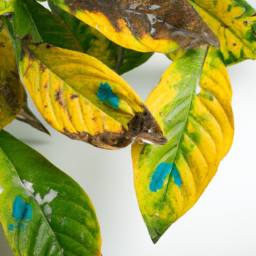
Identifying and Treating Mold in Plants
Hello there! In this guide, we will explore the fascinating world of plant diseases, focusing specifically on mold. Mold can be a common issue for plant owners, causing yellow leaves, stunted growth, and overall poor health. But worry not! By understanding the signs and symptoms of mold infestation, you can take the necessary steps to identify and treat it effectively. Let’s dive in!
Understanding Mold in Plants
Mold, also known as fungus, is a type of microscopic organism that thrives in warm and humid environments. It reproduces by producing spores, which can spread easily through the air or by physical contact. When mold infects plants, it can lead to a range of problems, including discoloration, wilting, and even death if left untreated.
One of the most common types of mold found in plants is powdery mildew. Powdery mildew appears as a white or grayish powdery substance on the leaves, stems, and flowers of infected plants. Another common type is downy mildew, which typically manifests as yellow patches on the upper surface of leaves.
Now that we have a basic understanding of mold in plants, let’s move on to identifying the signs of mold infestation.
Identifying Mold Infestation
1. Yellowing Leaves: One of the first signs of mold infestation is the appearance of yellow leaves. If you notice your plant’s leaves turning yellow, especially in a spotted or patchy pattern, it may indicate a mold problem.
2. White Powdery Substance: As mentioned earlier, powdery mildew appears as a white or grayish powdery substance on the plant’s surface. Look closely at the leaves, stems, and flowers for any signs of this powdery coating.
3. Wilting and Stunted Growth: Mold-infected plants often exhibit wilting and stunted growth. If your plant is not thriving as it should, despite proper care and maintenance, mold could be the culprit.
4. Distorted Leaves or Flowers: Another indicator of mold infestation is the distortion of leaves or flowers. Mold can cause abnormal growth patterns, resulting in misshapen or deformed plant parts.
5. Foul Odor: In some cases, mold-infested plants emit a foul odor. If you notice an unpleasant smell coming from your plant, it’s worth investigating for mold.
Treating Mold Infestation
Now that you have identified a mold infestation in your plant, it’s time to take action. Here are some steps you can follow to treat mold effectively:
1. Isolate the Infected Plant: As soon as you notice mold on a plant, it’s crucial to isolate it from other healthy plants. This will prevent the spread of spores and minimize the risk of further infestation.
2. Prune Infected Parts: Carefully prune and remove any infected leaves, stems, or flowers. Be sure to sanitize your pruning tools between cuts to avoid spreading the mold to other parts of the plant.
3. Improve Air Circulation: Mold thrives in stagnant air, so improving air circulation around your plants can help prevent further mold growth. Consider placing a fan nearby or repositioning your plants to allow for better airflow.
4. Adjust Watering Practices: Overwatering can create a moist environment that promotes mold growth. Ensure your plants receive adequate but not excessive water. Water at the base of the plant, avoiding wetting the leaves, which can encourage mold development.
5. Apply Fungicides: In severe cases, where mold infestation is widespread, applying a suitable fungicide may be necessary. Consult with a local gardening expert or nursery to identify the most appropriate fungicide for your specific plant and mold type.
Remember, prevention is always better than cure. Regularly inspect your plants for any signs of mold or other diseases. Maintain proper plant care practices, including providing adequate sunlight, avoiding overcrowding, and ensuring proper drainage. By keeping your plants healthy and happy, you can minimize the risk of mold infestation.
In conclusion, identifying and treating mold in plants is crucial for their overall well-being. By familiarizing yourself with the signs of mold infestation and taking prompt action, you can save your plants from further damage. Remember to be observant, patient, and proactive in your plant care routine. Happy gardening!
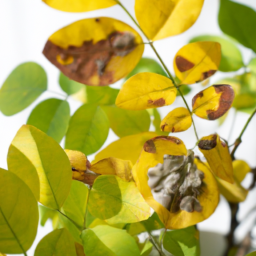
Other Symptoms and Methods of Diagnosing Plant Diseases
Diagnosing plant diseases can be a challenging task, but with careful observation and analysis, you can identify and treat various issues that may be affecting your plants. In addition to yellow leaves and mold, there are other symptoms that can indicate the presence of diseases. By understanding these symptoms and using effective diagnostic methods, you can ensure the health and vitality of your plants. Let’s explore some of these symptoms and methods in detail.
1. Stunted Growth and Wilting
One common symptom of plant diseases is stunted growth and wilting. If you notice that your plants are not growing as expected or if they appear weak and droopy, it could be an indication of an underlying disease. Stunted growth and wilting can be caused by various factors, including fungal infections, nutrient deficiencies, or even root rot.
To diagnose the specific disease, carefully examine the affected plants. Look for any discoloration or lesions on the leaves, stems, or roots. Pay attention to the soil moisture and drainage as well. If the soil is consistently wet and the roots appear brown and mushy, it could be a sign of root rot. On the other hand, if the soil is dry and the leaves are yellowing, the plants may be suffering from nutrient deficiencies.
To confirm the diagnosis, you can conduct a soil test to determine the nutrient levels and pH. Additionally, you may need to take a sample of the affected plant parts and send it to a plant pathology laboratory for further analysis. This will help you identify the specific pathogen causing the disease and guide you in selecting the appropriate treatment.
2. Leaf Spots and Blight
Leaf spots and blight are another common symptom of plant diseases. These are characterized by the presence of small to large spots or lesions on the leaves. The spots may vary in color, ranging from brown, black, or yellow. Leaf spots can be caused by bacteria, fungi, or even viruses.
When diagnosing leaf spots and blight, it is important to consider the overall appearance of the affected plants. Are the spots confined to the leaves or do they also appear on the stems and fruits? Are the spots surrounded by a yellow halo or do they have a distinct border? These observations can provide valuable clues about the specific pathogen causing the disease.
In some cases, leaf spots and blight can be managed by simply removing and destroying the affected plant parts. However, if the disease is severe or recurrent, you may need to consider using fungicides or other appropriate treatments. Consult with a plant disease specialist or your local extension office for guidance on the best course of action.
3. Abnormal Growth and Deformities
Abnormal growth and deformities in plants can also indicate the presence of diseases. This includes the appearance of galls, witches’ brooms, or distorted leaves and flowers. These symptoms are often caused by pathogens such as nematodes, viruses, or phytoplasmas.
When diagnosing abnormal growth and deformities, closely examine the affected plant parts. Look for any unusual swellings, knots, or clusters of abnormal tissue. Pay attention to the overall shape and structure of the plants. Are they growing in a twisted or distorted manner? These observations can help you narrow down the potential causes of the issue.
Unfortunately, treating diseases that cause abnormal growth and deformities can be challenging. In some cases, it may be best to remove and destroy the affected plants to prevent the spread of the disease to other healthy plants. However, if the affected plants are valuable or irreplaceable, you may need to consult with a plant disease expert to explore potential treatment options.
Remember, diagnosing plant diseases requires careful observation, analysis, and sometimes professional expertise. By understanding the various symptoms and utilizing effective diagnostic methods, you can take appropriate measures to protect your plants from diseases and ensure their overall health and well-being.
In Summary
Have you ever noticed your plants looking a little under the weather? Maybe their leaves turned yellow or developed some strange mold. Don’t worry, you’re not alone! Plant diseases can be a common problem for many gardeners, but diagnosing them can be a bit tricky. In this blog post, we’ll explore some common signs of plant diseases and how you can identify and treat them to keep your green friends happy and healthy.
One telltale sign that something might be wrong with your plants is yellow leaves. While it’s normal for older leaves to turn yellow and fall off, if you notice this happening to newer leaves, it could be a sign of a disease. One possible culprit is a nutrient deficiency, such as lack of nitrogen or iron. However, yellow leaves can also indicate a fungal or bacterial infection. If you see yellowing leaves, it’s important to examine them closely and look for any other symptoms, like spots or lesions, which can help narrow down the cause. Additionally, if you notice a fuzzy white or gray mold on your plants, it’s likely that they have fallen victim to powdery mildew. This common fungal disease can affect a wide range of plants and is often caused by poor air circulation or high humidity. To treat powdery mildew, you can try removing and disposing of infected leaves, improving air circulation around the plants, or using fungicides as a last resort. Remember, prevention is key, so make sure to keep your plants well-spaced and avoid overwatering.
Here are some questions from our readers:
Q1: Why are my plant’s leaves turning yellow?
A1: There can be several reasons why your plant’s leaves are turning yellow. One common cause is nutrient deficiency, particularly a lack of nitrogen. Other possible causes include overwatering, underwatering, poor drainage, or exposure to extreme temperatures. It’s important to assess the overall health of your plant, consider its specific needs, and make any necessary adjustments to its care.
Q2: How can I identify mold on my plants?
A2: Identifying mold on plants can be relatively easy. Look for fuzzy or powdery growth on the leaves, stems, or flowers. The color of the mold can vary, but it is often white, gray, or black. Mold can also cause a musty odor. If you suspect mold, gently inspect your plant and take necessary precautions to prevent its spread, such as improving air circulation, reducing humidity, or using organic fungicides.
Q3: What are some common signs of plant diseases?
A3: There are several common signs that indicate your plant may be suffering from a disease. Apart from yellowing leaves and mold, other signs include wilting, stunted growth, brown spots, lesions, distorted or misshapen leaves, and abnormal discoloration. It’s important to closely observe your plants for any unusual symptoms and take appropriate measures to diagnose and treat the underlying disease.
Q4: How can I diagnose plant diseases?
A4: Diagnosing plant diseases can be challenging as many diseases share similar symptoms. To begin, carefully examine the affected plant parts, noting any visible signs like spots, lesions, or discoloration. Consider environmental factors, such as temperature and humidity, as they can contribute to certain diseases. If you’re unsure, consult gardening resources, local extension services, or seek advice from experienced gardeners or horticulturists.
Q5: What steps can I take to prevent and treat plant diseases?
A5: Preventing and treating plant diseases involves a combination of good plant care practices and targeted interventions. Maintain proper watering practices, ensuring adequate drainage and avoiding overwatering. Provide plants with appropriate sunlight and optimal growing conditions. Regularly inspect plants for signs of diseases and promptly remove any infected plant parts. Consider using organic fungicides or other treatments recommended for specific diseases. Additionally, practicing crop rotation and maintaining overall garden hygiene can help prevent the spread of diseases.
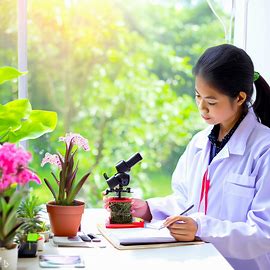
Lisa Chen is a seasoned indoor gardening expert and the author of several bestselling books on the topic. With a background in horticulture and urban farming, Lisa is dedicated to helping urban dwellers embrace the joys of cultivating green spaces indoors. Her detailed guides and hands-on tips empower readers to transform their living spaces into thriving plant sanctuaries.

